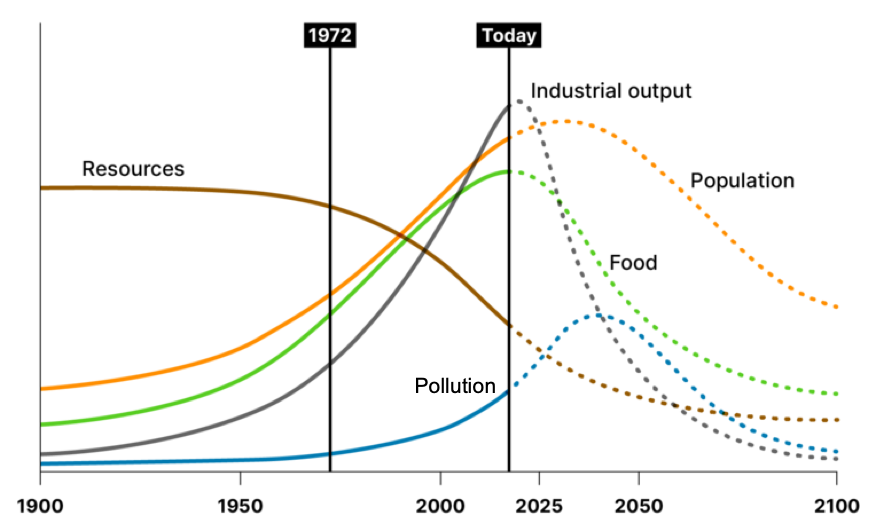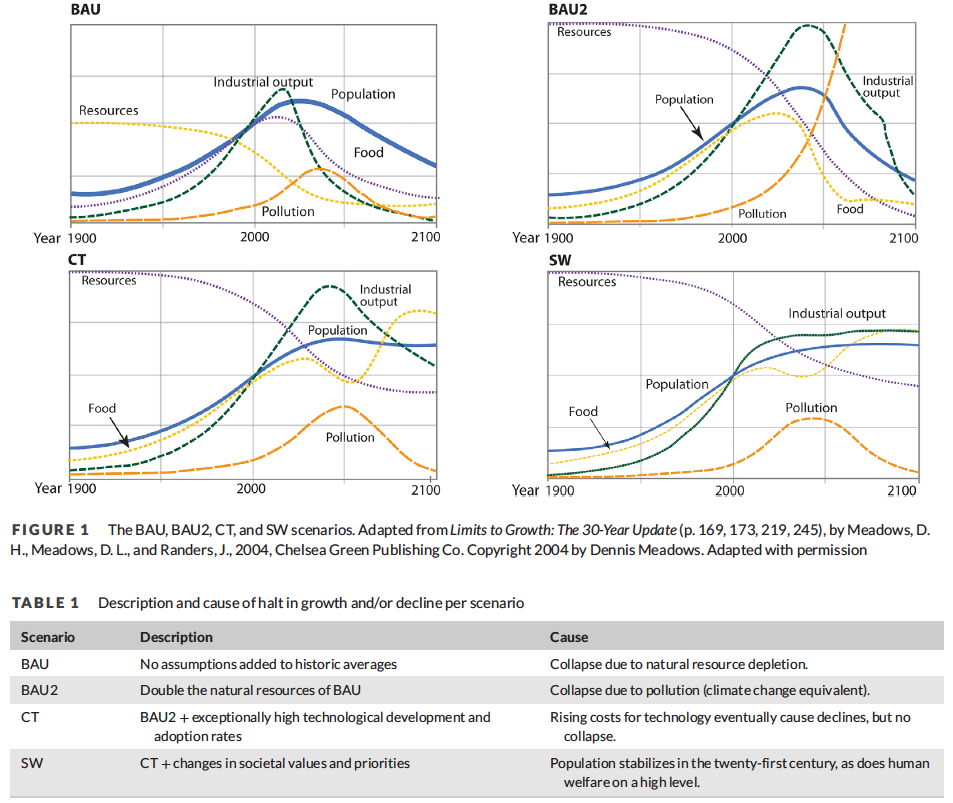
Limits to Growth
The Limits to Growth
In 1972, the Limits to Growth (LtG) models were developed by Donella Meadows et al. to show the system dynamics of limits to growth on a finite planet. The model included 5 main variables (population, industrial production, resources, food production and pollution) and showed that if we continued in a trajectory of endless economic growth humanity would deplete its resources and pollute the biosphere in the next 100 years resulting in an uncontrollable collapse.
This figure shows the BAU 1 scenario which had tended to follow the data relatively well. Source: Meadows et al (1972), Earth4all
The 3 Main Conclusion of Limits to Growth:
1) If the present growth trends in world population, industrialization, pollution, food production, and resource depletion continue unchanged, the limits to growth on this planet will be reached sometime within the next one hundred years. The most probable result will be a rather sudden and uncontrollable decline in both population and industrial capacity.
2) It is possible to alter these growth trends and to establish a condition of ecological and economic stability that is sustainable far into the future. The state of global equilibrium could be designed so that the basic material needs of each person on earth are satisfied and each person has an equal opportunity to realize his individual human potential.
3) If the world's people decide to strive for this second outcome rather than the first, the sooner they begin working to attain it, the greater will be their chances of success.
Updates to LtG
A recent update to LtG by Herrington (2021) shows that all scenarios are relatively close to the data values, but there are differences among some variables. However, BAU2 and CT are aligned the closest to the data points in this new update: “BAU2 and CT scenarios show a halt in growth within a decade or so from now. Both scenarios thus indicate that continuing business as usual, that is, pursuing continuous growth, is not possible. Even when paired with unprecedented technological development and adoption, business as usual as modeled by LtG would inevitably lead to declines in industrial capital, agricultural output, and welfare levels within this century.”
The 4 main scenarios of LtG. Source: Herrington (2021).
The Limits to Growth 50 Years Later
It has been 50 years since the Limits to Growth (LtG) report, sponsored by the Club of Rome, became one of the top-selling environmental titles ever published in 1972, with more than 30 million copies sold in 30 languages. In the early 1970s, MIT's Jay Forrester assembled a team of up-and-coming experts in the emergent field of complex systems that included Donella Meadows, Dennis Meadows, Jørgen Randers, and William Behrens III to uncover the system dynamics of what would happen if humanity allowed unconstrained population and economic growth in a biophysically finite planet. 50 years later, humanity is faced with increasing ecological and social crises that merit revisiting the warnings in LtG to envision and realize systems change that can enable us to achieve a just sustainability transformation to a right-sized economy in this decade of action.
From Limits to Growth to an Earth4All: The 5 Turnaround Needed for an Earth4All
Would you like to read more?
Meadows, D. H., Meadows, D. L., Randers, J., & Behrens, W. W. (1972). The limits to growth: A report for the Club of Rome’s project on the predicament of mankind. New York: Universe Books.
Hall, C.A. and Day, J.W., 2009. Revisiting the Limits to Growth After Peak Oil: In the 1970s a rising world population and the finite resources available to support it were hot topics. Interest faded—but it's time to take another look. American scientist, 97(3), pp.230-237.


